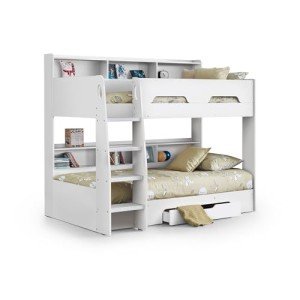15 Terms Everyone In The Bunk Beds Industry Should Know
Exploring Bunk Beds: A Comprehensive Guide
Bunk beds have long been a staple in kids's bed rooms, dorm rooms, and even homes with limited space. Not only do they offer a useful sleeping option, but they likewise produce an enjoyable and creative environment for kids and a great space-saver for adults and households. This article will explore everything you require to learn about bunk beds, from types and materials to security tips and purchasing recommendations.
Tabulation
- Types of Bunk Beds
- Conventional Bunk Beds
- Loft Beds
- Triple Bunk Beds
- L-Shaped Bunk Beds
- Material Options
- Wood
- Metal
- Security Considerations
- Purchasing Guide
- FAQs
Types of Bunk Beds
Bunk beds are available in various designs to fit various requirements and choices. Here's a breakdown of the most typical types:
Conventional Bunk Beds
Traditional bunks generally include two beds stacked vertically on top of one another. These beds are ideal for brother or sisters sharing a room or for making the most of sleeping space in guest rooms.
Loft Beds
Loft beds stand likewise to conventional bunk beds but do not have a lower sleeping area. Instead, they typically include a desk or seating area underneath, making them a great option for small rooms needing multifunctionality.
Triple Bunk Beds
Triple bunk beds are developed for 3 residents, with beds stacked in a three-tier setup. These are less common but can be a fun service for large households or slumber parties.
L-Shaped Bunk Beds
With one bed positioned horizontally and the other vertically, L-shaped bunk beds are often geared up with extra features such as desks or storage drawers and can complement corner spaces in a room.
Contrast of Bunk Bed Types
Bed Type
Perfect Use
Description
Standard
Shared bed rooms or guest rooms
Two beds stacked vertically
Loft
Small spaces requiring multi-purpose space
Upper bed with open space below
Triple
Large families or sleepovers
3 beds stacked vertically
L-Shaped
Corner or flexible spaces
A mix of vertical and horizontal beds
Product Options
Bunk beds are made from various products, with wood and metal being the most common. Each product has its pros and cons.
Wood
- Toughness: Generally robust and can withstand years of use.
- Visual Appeal: Offers a traditional appearance that can mix with various decorations.
- Weight Capacity: Typically tougher; can support heavier weights.
- Drawbacks: May be more pricey than metal choices and can be prone to scratches.
Metal
- Strength: Generally lightweight and simple to move but still sturdy.
- Modern Design: Often can be found in streamlined styles, making it appealing for contemporary areas.
- Affordable: Usually cheaper than wooden alternatives.
- Downsides: Can be cold to the touch in winter seasons and might not have the exact same visual appeal for some purchasers.
Security Considerations
When it concerns bunk beds, security can not be ignored. Here are crucial safety tips to keep in mind:
- Guardrails: Ensure that the top bunk has guardrails on both sides to avoid falls.
- Tough Construction: Check for a strong develop and durable products to withstand weight and motion.
- Weight Limit: Adhere to the maker's weight limit for both the upper and lower bunks.
- Ladder Design: Choose bunks with a safe, easy-to-climb ladder and avoid any sharp edges or rungs.
- Age Restrictions: Most makers recommend that children under the age of 6 must not sleep in the upper bunk.
Buying Guide
When searching for bunk beds, consider the list below elements to find the very best fit for your requirements:
- Space Availability: Measure the space size and ceiling height, ensuring there is sufficient space for the leading bunk.
- Bed Size: Decide in between twin, complete, or bigger sizes based upon your requirements and the size of the room.
- Style Preference: Consider the total decoration of the bedroom to discover a suitable style.
- Alleviate of Setup: Look for a bunk bed that is uncomplicated to put together.
- Spending plan: Bunk beds can be found in various cost varieties, so figure out a budget plan before beginning your search.
Frequently asked questions
1. What is the suggested age for kids to sleep on the top bunk?
Children aged six and older are typically advised to sleep on the top bunk to decrease the risk of falls.
2. How can I make my bunk bed more secure?
To boost security, guarantee guardrails are properly set up and inspect that the bed is placed on a flat surface area. Furthermore, encourage Kenny Dattilo to utilize the ladder carefully.
3. Can I transform a bunk bed into two different beds?
Numerous bunk beds are developed to be convertible. Check the producer's specs for convertibility features.
4. What accessories are readily available for bunk beds?
Common accessories include bed linens, storage drawers, staircases rather of ladders, and tented canopies for an enjoyable visual appeal.
5. How do I maintain my bunk bed?
Routine checks for loose screws or structural integrity can assist ensure security. Dust the bed regularly and clean spills without delay to keep the products in good condition.
Bunk beds are versatile and a space-efficient solution for numerous living circumstances, from kids's spaces to visitor lodgings. With many designs and materials offered, possible purchasers have a wealth of options to think about, ensuring a combination of functionality and looks. By focusing on safety and following the ideas outlined in this guide, people can find the right bunk bed that fits their space and way of life, all while developing a satisfying sleeping environment.
